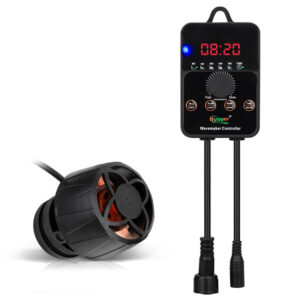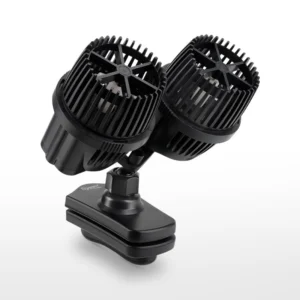A wave maker can rotate the aquarium water and make waves, which avoids stagnant water areas. Actually, water flow is essential for a fish tank. It helps to remove unnecessary substances or waste from the tank, while it also meets some fish’s needs for strong water flow. And today’s article will walk you through something you need to know about the aquarium wave maker, like what makes waves in an aquarium, how long to leave the wave maker on in an aquarium, etc. So let’s get started right away.
Content Table
Is an aquarium wave maker pump necessary
The purposes of a wave maker in an aquarium
Do you know the purposes of a wave maker in an aquarium? If you know little about that, just continue reading.
- Blow away the fish feces in your aquarium
An aquarium wave maker can rotate the water and circulate the water flow. It is helpful to move the fish feces or waste to the pump suction inlet. Then these unnecessary substances will be sucked away from your tank.
- Reduce the fight between fish in your aquarium
Being distracted by the water flow and pressure created by the aquarium wave maker, fish may show less aggression. Consequently, aggressive fish would fight less with other fish.
- Strengthen fish body
In nature, some fish live in the wind and waves. If you keep them in a fish tank without strong water flow, they may become short, thick, and obese. Luckily, you can add an aquarium wave maker to mimic their natural environment. Then fish will move around the tank because of the strong water currents. Long-term movement is beneficial to strengthen the fish body. Accordingly, reduces the risk of suffering from fish disease.

The application of wave makers in aquariums
Is a wave maker pump necessary for your aquarium? The short and definitive answer is no because an aquarium filter can also agitate the water surface and supply oxygen. Whether your aquarium needs a wave maker or not depends on the aquatic pets. For instance, if the fish you keep are fond of fast-moving waters, then it is best to add an aquarium wave maker to create strong water currents.
However, you should not add a wavemaker in the case of some situations. For example, for tanks keeping fish that are fond of slow-moving waters, there is no need to make waves in it. Like, guppy fish, molly fish, and platyfish.
How long to leave the wave maker on
How long to leave on a wave maker
In the table below, we will mention the recommended running time for a wavemaker. Just take it as a reference.
| Fish Status | Requirements & Running Time for Wavemaker |
| Young fish stage |
|
| Mid-fish stage |
|
| Adult fish stage |
|
Maintenance tips for an aquarium wave maker
- Clean the wave maker regularly, for instance, every 3 months, or clean thoroughly every half of the year.
- Keep the controller dry
- Rinse the debris in the wavemaker pump
- Wipe the blades with a towel
What size wavemaker do I need for a 200 gallon fish tank
While determining which wavemaker should you get, you should consider the flow rate, aquarium size, and the substrate in the fish tank. Generally, the aquarium water should be cycled 10 times. Also, large tanks may need more than one wavemaker, compared with small tanks. Besides that, the substrate in your tank should be taken into consideration. For example, if your aquarium substrate is fine sand, it will be blown around the tank easily. Then what size wavemaker is the best one?
Additionally, take a 200-gallon fish tank as an example. The flow rate should reach 2000 GPH. Then double head wave makers are the excellent alternative. It is a quiet wave maker with a 360-degree adjustable power head, which is ideal for both freshwater and saltwater aquariums. Also, a double-head wave maker makes the waves longer and more powerful. And the water wave can reach a wide range of your aquarium.

Place the wave maker in the tank
Adding a wave maker will make waves and create a vortex in your aquarium. However, the functions of the wave maker may vary in its location in the tank. Next, let’s take the hygger wavemaker as an example.
| Location | Functions |
| On the bottom of the tank | Clean the residues |
| In the middle of the tank | Exercise the fish’s body |
| On the upper of the tank | Make waves on the water |
Additionally, if you have no idea about how to place a wavemaker in the aquarium, you can take a look at the following tips.
- Tanks with water level below 50 cm: 10-15 cm up from the bottom of the tank and 45 degrees down from the wave crest.
- Tanks with water level over 55 cm: 15 cm down from the top of the tank and 45 degrees down from the wave outlet.
- Never expose the wave maker above the water’s surface, and you should ensure that the wave maker head is fully submerged in the water.
Relevant topic
How to Use Wave Maker in Aquarium


Leave a comment